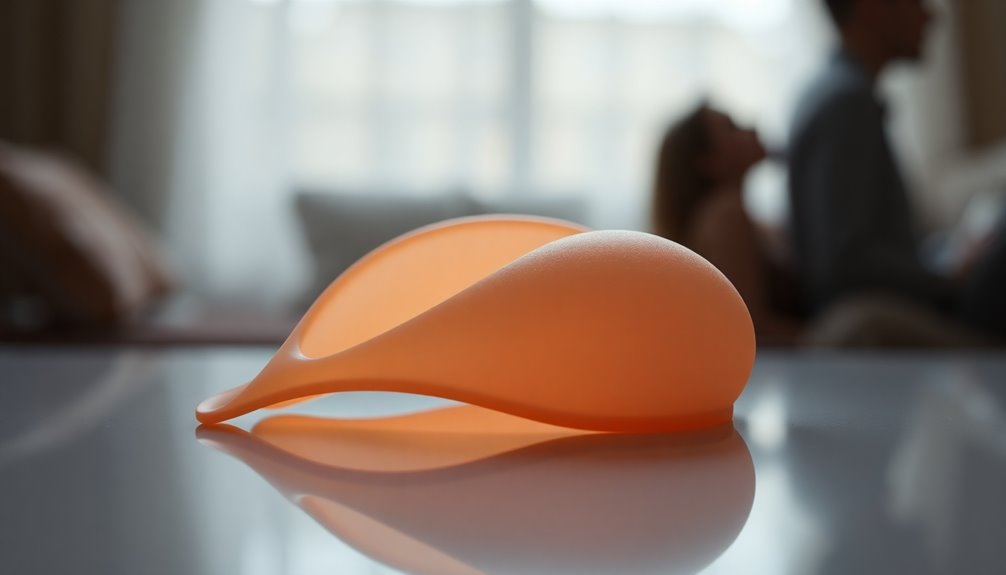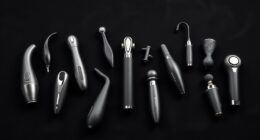If you're looking for effective alternatives to unprotected sex, consider barrier methods like diaphragms, cervical caps, or sponges. These options block sperm from reaching the uterus and can offer varying effectiveness. The pull-out method is another natural choice, requiring precise timing for withdrawal. For those interested in tracking fertility, using methods that monitor your cycle can also help. Remember, while these methods can reduce the risk of pregnancy, they generally don't protect against STIs. Exploring the details of each method can help you make an informed choice that suits your needs.
Key Takeaways
- Consider a diaphragm, which effectively blocks sperm from entering the uterus when used with spermicide.
- A cervical cap offers a snug fit over the cervix and requires spermicide for optimal effectiveness.
- The sponge method provides protection for up to 24 hours and is also used with spermicide for better results.
- Fertility awareness methods can help track your fertile days, but may require additional barrier methods during those times.
- The pull-out method, while a natural alternative, has varying effectiveness and does not protect against STIs; consider combining it with other methods.
Diaphragm Overview

A diaphragm is a flexible, dome-shaped barrier made of soft silicone that's designed to prevent sperm from entering the uterus. You insert it into the vagina, covering the cervix to block sperm from reaching the womb.
Available in various sizes, including a convenient one-size self-fitting model like Caya, diaphragms are reusable and made of silicone. When used correctly with spermicide, they're 92-96% effective at preventing pregnancy. However, in real-world use, effectiveness drops to about 83-84% due to inconsistent usage. The diaphragm is also important because it plays a role in regulating intra-abdominal pressure, which can enhance comfort during use.
To maximize effectiveness, insert it before sex and leave it in for at least six hours afterward. Remember, diaphragms don't protect against STIs, so consider additional protection if needed.
Cervical Cap Details

Cervical caps offer a unique contraceptive option that fits snugly over the cervix to prevent sperm from entering the uterus. To use one effectively, apply spermicide to the cap before inserting it into your vagina, ensuring it covers the cervix. You can leave the cap in place for up to 40 hours before intercourse. If you have sex multiple times, add more spermicide each time. After your last intercourse, keep the cap in for at least six hours but remove it within 48 hours. For those who've not given birth vaginally, the cap's effectiveness ranges from 86-91%. However, it's important to note that the cervical cap requires a prescription and fitting from a healthcare provider to ensure proper usage.
Sponge Method Explained

The sponge method is an effective contraceptive option that many women find convenient. This small, round device is made from soft, squishy plastic and contains spermicide to help prevent pregnancy.
You insert the sponge deep inside your vagina, where it snugly covers the cervix, blocking sperm from entering the uterus. It provides protection for up to 24 hours and must be left in place for at least 6 hours after intercourse, but no longer than 30 hours total. The sponge works by blocking sperm from reaching the egg and can be used alone or in combination with condoms for additional protection.
When used perfectly, the sponge is 91% effective for women who've never given birth and 80% for those who have.
For added protection, consider using it with condoms, which also guard against STDs that the sponge doesn't protect you from.
Fertility Awareness Method

Understanding your fertility can be a powerful tool for managing your reproductive health. The Fertility Awareness Method (FAM) helps you track your fertile window, whether you're trying to avoid or plan a pregnancy.
You can use calendars, observe body signs like cervical fluid, or check your basal body temperature to predict fertility. Common methods include the Standard Days Method and the Billings Ovulation Method. FAM predicts fertile times based on hormonal changes during the menstrual cycle, which is crucial for accurate tracking.
It's essential to use these methods consistently for effectiveness, as typical use can lead to 12–24 pregnancies per 100 women yearly. FAM is cost-effective and doesn't rely on medications or devices.
Just remember, you'll need to abstain from sex or use barrier methods during your fertile days to prevent pregnancy.
Pull-out Method Insights

While many consider the pull-out method a natural alternative for birth control, its effectiveness varies considerably depending on how well it's practiced.
With perfect use, it's about 96% effective, but in typical use, that drops to around 73-78%. This means about 22 out of 100 women using this method will become pregnant each year.
Timing is essential; the male partner must pull out before ejaculation, which can be challenging. Keep in mind that pre-ejaculate fluid may still contain sperm, posing a risk. Approximately 22% of users may become pregnant annually with the pull-out method.
The method doesn't protect against STDs and can reduce pleasure for both partners. For better results, consider using it alongside other birth control methods and keep emergency contraception handy.
Consistency is key!
Hormonal Contraception Options

When it comes to effective birth control, hormonal contraception offers a variety of options tailored to different lifestyles and preferences.
You can choose the birth control pill, which comes in combined or mini-pill forms, and is up to 99% effective if taken consistently. Emergency contraception is also available for situations where contraceptive methods fail.
The hormonal contraceptive patch is another option; it's easy to use, applied weekly, and releases hormones continuously.
The vaginal contraceptive ring requires minimal action, being placed for three weeks before removal.
If you prefer a long-term solution, the hormonal contraceptive implant lasts up to three years, effectively preventing ovulation.
Each method has its pros and cons, so you can find what fits best with your routine and needs.
Comparing Effectiveness Rates

Choosing the right birth control method involves not only personal preference but also an understanding of effectiveness rates across different options.
Emergency contraception can prevent over 95% of pregnancies when taken within five days after unprotected sex, with IUDs being the most effective at 99.5%. Bullet points enhance readability and organization in research papers by breaking down complex information into manageable segments.
For oral contraceptives, timing is essential, offering 97% to 99% effectiveness if taken correctly. In contrast, barrier methods like male condoms are about 98% effective, while diaphragms reach around 94%.
Remember, the sooner you use emergency contraception, the better its efficacy.
Additionally, condoms are unique in providing protection against STDs, making them an important choice for overall safety.
Always prioritize correct usage to maximize effectiveness across any method you choose.
Frequently Asked Questions
Can I Use More Than One Method Simultaneously?
Yes, you can definitely use more than one method simultaneously.
Combining methods, like hormonal birth control with condoms, maximizes your pregnancy prevention and protects against STDs. This approach offers extra assurance since no method is 100% effective on its own.
Just be mindful that combining two hormonal methods may not improve effectiveness and could cause side effects.
Always consult your healthcare provider to find the best combination for your health and needs.
How Do I Properly Insert a Diaphragm or Cervical Cap?
To properly insert a diaphragm or cervical cap, start by washing your hands and applying spermicide.
For the diaphragm, fold it with the dome down and insert it towards your tailbone, ensuring it covers your cervix.
For the cervical cap, fold it and insert it with the strap down, pushing it to cover the cervix securely.
Make sure it's well-positioned, and check both after insertion to confirm they fit correctly.
What Should I Do if I Forget to Use Spermicide?
If you forget to use spermicide with your diaphragm or cervical cap, don't panic.
First, you should avoid intercourse until you can apply spermicide. If you've already had sex without it, consider using emergency contraception as a backup option.
Remember, spermicide enhances effectiveness, so always try to use it.
Moving forward, set reminders for yourself to guarantee you don't forget next time, and keep spermicide handy.
Are There Side Effects Associated With Using These Contraceptive Methods?
Yes, there are some side effects associated with emergency contraceptive methods.
You might experience headaches, nausea, or fatigue, though these are generally mild and affect a small percentage of users.
Your menstrual cycle could also be impacted, with your period arriving earlier or later than usual.
However, emergency contraception is considered very safe, with no serious side effects, and it doesn't affect your future fertility.
How Do I Know When I'm Ovulating for Fertility Awareness?
To know when you're ovulating for fertility awareness, track your basal body temperature daily.
You'll notice a slight rise after ovulation. Also, observe changes in your cervical mucus; it becomes clear and slippery before ovulation.
Utilize calendar methods by estimating your fertile window based on your cycle length.
Finally, pay attention to any additional signs like mild cramps or increased libido.
Combining these methods increases accuracy in predicting your ovulation.
Conclusion
In exploring alternatives to unprotected sex, you've got several effective options. From diaphragms and cervical caps to the sponge method and fertility awareness, each method has its unique benefits. Don't forget the pull-out method and hormonal contraception, which can also play a role in your decision-making. Remember, understanding the effectiveness rates of these methods is essential for making informed choices that suit your lifestyle and reproductive health. Stay safe and empowered in your sexual health journey!










